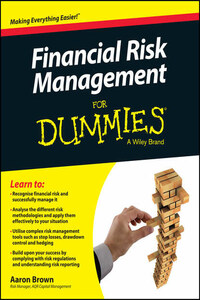![title page image]()
Financial Risk Management For Dummies>®
Published by: John Wiley & Sons, Ltd., The Atrium, Southern Gate, Chichester, www.wiley.com
This edition first published 2016
© 2016 John Wiley & Sons, Ltd, Chichester, West Sussex.
Registered office
John Wiley & Sons Ltd, The Atrium, Southern Gate, Chichester, West Sussex, PO19 8SQ, United Kingdom
For details of our global editorial offices, for customer services and for information about how to apply for permission to reuse the copyright material in this book please see our website at www.wiley.com.
The right of the author to be identified as the author of this work has been asserted in accordance with the Copyright, Designs and Patents Act 1988
All rights reserved. No part of this publication may be reproduced, stored in a retrieval system, or transmitted, in any form or by any means, electronic, mechanical, photocopying, recording or otherwise, except as permitted by the UK Copyright, Designs and Patents Act 1988, without the prior permission of the publisher.
Wiley publishes in a variety of print and electronic formats and by print-on-demand. Some material included with standard print versions of this book may not be included in e-books or in print-on-demand. If this book refers to media such as a CD or DVD that is not included in the version you purchased, you may download this material at http://booksupport.wiley.com. For more information about Wiley products, visit www.wiley.com.
Designations used by companies to distinguish their products are often claimed as trademarks. All brand names and product names used in this book are trade names, service marks, trademarks or registered trademarks of their respective owners. The publisher is not associated with any product or vendor mentioned in this book.
Limit of Liability/Disclaimer of Warranty: While the publisher and author have used their best efforts in preparing this book, they make no representations or warranties with the respect to the accuracy or completeness of the contents of this book and specifically disclaim any implied warranties of merchantability or fitness for a particular purpose. It is sold on the understanding that the publisher is not engaged in rendering professional services and neither the publisher nor the author shall be liable for damages arising herefrom. If professional advice or other expert assistance is required, the services of a competent professional should be sought.
For general information on our other products and services, please contact our Customer Care Department within the U.S. at 877-762-2974, outside the U.S. at (001) 317-572-3993, or fax 317-572-4002. For technical support, please visit www.wiley.com/techsupport.
For technical support, please visit www.wiley.com/techsupport.
A catalogue record for this book is available from the British Library.
Library of Congress Control Number: 2015951253
ISBN 978-1-119-08220-0 (hardback/paperback) ISBN 978-1-119-08218-7 (ebk)
ISBN 978-1-119-08219-4 (ebk)
Risk management is about preparing for anything that might happen. People who try to predict the future are the enemies of risk management. They’re the ones who say, ‘Let’s build a wall on the north side of town because that’s where we predict the attack will come.’ Risk managers know that leaving any gap in the wall means the attackers will exploit the gap.
Preventing disaster is easy – you just don’t take any risk. Risk management is about surviving disaster, not preventing it. If there weren’t disasters, you wouldn’t call it risk. You need risk – and its attendant disasters – to learn, to grow, to excel.
If you want to be a risk manager, this book gives you a good start. You need practice at risk taking, plus some maths and financial theory, plus some practice at finance. If you already have all of those things, you should be writing this book, not reading it.
People have been concerned about risk as long as there have been people. Financial Risk Management For Dummies explains the background and some theory about risk, quantitative analysis of risk and modern financial risk management and shows you how to apply them in practice, without jargon or mathematics. Okay, I throw in a few examples that require addition and multiplication, but they’re clearly labelled and can be skipped, and I also give you lots of simple, specific illustrations.
This book tells you what financial risk managers do and why they do it.
I make three different guesses about who you are and why you’re reading this book:
✔ You’re currently, or hope to be, a financial manager, and you want to delve into the risk management aspect of your job. By itself, this book cannot teach you that, but if you already know the basic financial theory and mathematics or go elsewhere to discover them, this book can show you how to apply them properly to become a good financial risk manager.
✔ You work with financial risk managers and want to understand how they see things. This book can show you the world from their perspective, and help you form constructive partnerships.








